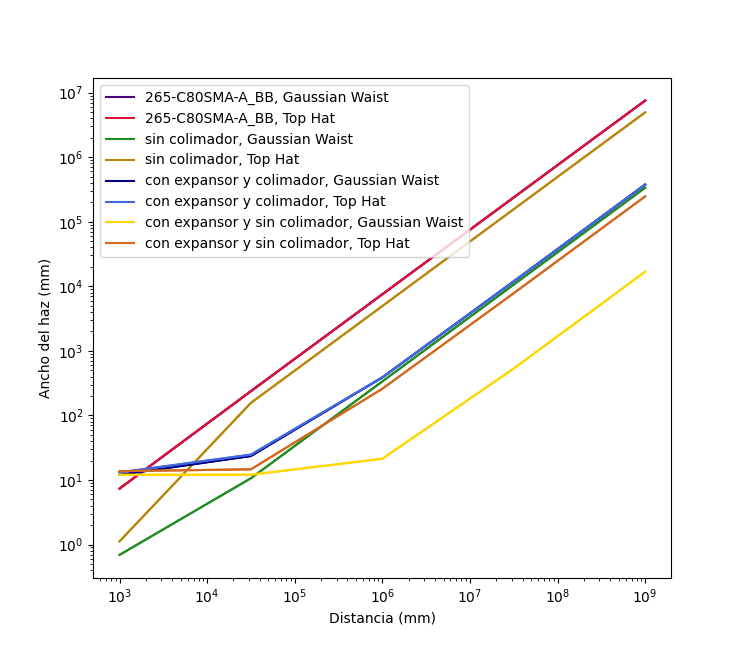-
-
June 25, 2025 at 11:40 am
daniel.lopez.fernandez1
SubscriberI've been benchmarking the performance of a fiber laser collimator (https://www.thorlabs.com/thorproduct.cfm?partnumber=C80SMA-A) at long distances using POP. The fiber has a diameter of 0.6mm and an aperture of 0.37. For that purpose, I've created the files and the python code attatched that measures the beamwidth at different distances for several setups (with the colimator, '265-C80SMA-A_BB.zmx'; with a beam expander, 'hazsinnada_expansor1.zmx'; with the beam expander and the collimator, '265-C80SMA-A_BB_expansor2.zmx', and without anything, 'hazsinnada_funcional5.zmx'). The code that creates the plot is 'simulationcode.py'. The code loads each file and pulls out the beam divergence for a sweep of distances and two initial beam shapes, gaussian and top hat. The results that I get are surprising to say the least (you can see them in the image that the code creates or in the image 'image.png') as the collimator doesn't seem to collimate anything at all, the divergence is worse than the bare divergence of the beam. Are my simulations working properly and the collimator doesn't work for my setup or did I mess anything up?
The files that I mentioned (I wasn't able to share them through the forum directly):
https://www.dropbox.com/t/acXCBqSEpUkdB748
Thanks in advance :)
-
June 30, 2025 at 7:30 am
Niki Papachristou
Ansys EmployeeHi Daniel,
Thank you for reaching out to us! Your study sounds really interesting and sorry to hear that you do not feel sure about the results! From my side unfortunately, I am not able to download your code to test it. One way I can think of to test your results is to mannually take some beam size values for specific distances out for your ZOS desings and try to recreate these graphs. This way you will be able to see and compare if the problem is on your code on your desings. Have done that already?
Kind Regards,
Niki
-
June 30, 2025 at 8:48 am
daniel.lopez.fernandez1
SubscriberHi Niki,
Thank for taking your time answering! I have also tested manually the ZOS designs and obtained basically the same results. The settings that I use are: Thickness of the before last surface (in the file '265-C80SMA-A_BB_expansor2.zmx' is 10): the distance that I want to check and in the POP window: Start surface: 1, Last surface: (the number of the last surface that for example in '265-C80SMA-A_BB_expansor2.zmx' is 11, Beam type: TopHat or Gaussian, X-Sampling: 1024x1024, Y-Sampling: 1024x1024, X-Width: 5, Y-Width: 5, Waist X: 0.6 , Waist Y: 0.6 and the rest as default. Each file represents a different configuration: The bare beam: 'hazsinnada_funcional5.zmx', the beam with the commercial collimator: '265-C80SMA-A_BB.zmx', the beam with a beam expander: 'hazsinnada_expansor1.zmx' and the beam with the commercial colimator and the beam expander: '265-C80SMA-A_BB_expansor2.zmx'. If I set the distance to 1e7mm and a TopHat beam type I get the following beam widths:
Bare beam: 4,93952E+04 mm
Beam with the commercial collimator: 7,51553E+04 mm
Beam with a beam expander: 2,47796E+03 mm
Beam with both: 3,76877E+03 mm
which are the same results that I find with the code and show in the plot Beam Width (mm)/Distance (mm) and where it can be seen that the collimator decreases the performance of the system.
-
-
June 30, 2025 at 9:39 am
Niki Papachristou
Ansys EmployeeHi Daniel,
Thank you for the additional information here. One additional reason that I can think of for your case is the fact that the lenses you are reporting here where designed on sequential mode with specific parameters regarding the beam type. If you want to transfer this to POP (which by the way what it the reason for you to work with POP?) you have to make sure that you set up the beam parameters correclty to match the ones that the lenses where designed for. You can find more information here: Using Physical Optics Propagation (POP), Part 1: Inspecting the beams, Using POP, Part 2: Inspecting the beam intensities, Using Physical Optics Propagation (POP), Part 3: Inspecting the beam phases.
Kind Regards,
Niki
-
- You must be logged in to reply to this topic.



-
3492
-
1057
-
1051
-
965
-
942

© 2025 Copyright ANSYS, Inc. All rights reserved.








